Back to Journals » Psychology Research and Behavior Management » Volume 16
Application of Intelligent Lie Recognition Technology in Laws and Regulations Based on Occupational Mental Health Protection
Authors Tang X
Received 15 March 2023
Accepted for publication 6 July 2023
Published 2 August 2023 Volume 2023:16 Pages 2943—2959
DOI https://doi.org/10.2147/PRBM.S409723
Checked for plagiarism Yes
Review by Single anonymous peer review
Peer reviewer comments 2
Editor who approved publication: Dr Igor Elman
Xin Tang
School of Law, Chongqing University, Chongqing, 400044, People’s Republic of China
Correspondence: Xin Tang, Email [email protected]
Introduction: Since the reform and opening up, the social economy has developed rapidly. The competition in the employer market is fierce, which leads leaders to have strict requirements for workers, and workplace stress increases. The blind pursuit of corporate economic benefits has led to the neglect of workers’ mental health. Employee retaliation against the corporate occurs frequently. The perfection of the legal system for occupational mental health protection is imminent.
Methods: Based on the above questions, this study first introduces the research background, significance, and purpose in the introduction. Second, in the literature review, the current status of research is sorted out, the problems in the existing research are summarized, and the innovation points of this study are highlighted. Then, in the method section, the algorithms and models used here are introduced, including convolutional neural networks, long short-term memory networks, and the design of interview processes. Finally, the results of the questionnaire survey and the experimental test are analyzed.
Results: (1) There is further room for optimization of intelligent lie recognition technology. (2) The employee assistance program system can effectively solve the mental health problems of employees. (3) There is a need to expand the legislative mechanism for workers’ mental health protection at the legal level.
Discussion: This study mainly explores the loopholes of occupational mental health protection under the formulation of laws and regulations. Intelligent lie recognition technology reduces workers’ adverse physical and mental health risks due to work. It is dedicated to protecting workers’ legitimate rights and interests from the formulation of laws and regulations.
Keywords: workplace stress, intelligent lie recognition, employee assistance program system, legal protection, occupational mental health
Introduction
At this stage, the cause of national health is developing rapidly. China has successively issued corporate mental health policies, providing strong policy support for corporate mental health management. Mental health has attracted much attention as an essential part of the construction of healthy China. Chinese corporates are also increasingly paying attention to managing employees’ mental health.1 The corporate has done much helpful work on employees’ mental health, including holding mental health lectures, carrying out related activities, and implementing emergency crisis interventions. These jobs promote employee mental health. On the whole, the subdivision of the mental health management of corporate employees is not enough and lacks pertinence.2 At present, studies have shown that corporate social responsibility can improve employees’ positive attitudes and behaviors, such as job satisfaction, organizational commitment, and organizational citizenship behavior, and reduce employees’ turnover intention, counterproductive production behavior, deviant behavior, and others.3
There are many definitions of occupational health in the world, the most authoritative of which is given by the Joint Occupational Committee of the International Labor Organization and the World Health Organization. Occupational health shall be aimed at promoting and maintaining the physical, mental, and social excellence of workers in all professions. It prevents the health of employees from being affected by the work environment, protects employees from health hazards, and places employees in a working environment suitable for their physical and psychological environment. Some scholars have proposed that occupational health refers to the work field for the purpose of protecting employees’ health from harmful factors in occupational activities and the corresponding measures taken in law, technology, equipment, organizational system, and education. Occupational health is a medical issue related to the working environment and occupational conditions. Occupational health damage should not be limited to the work itself but related diseases induced by a combination of physiological, psychological, and biological factors, so occupational health should include physical health and mental health.
With the rapid development of technology, Artificial Intelligence (AI) is no longer imaginary. Intelligent lie recognition technology has entered the public’s field of vision. It can perform emotion recognition through the combination of humans and machines to judge whether the characters are aware of the relevant facts or even lie to conceal the truth. This technology is derived from psychological testing technology. It is widely used in the interrogation of criminal suspects at this stage. It can help investigators determine the direction of the investigation, find clues, and determine whether the suspect’s testimony is true. However, there will also be some limitations, and the technology needs to be updated and strengthened.4 AI vision technology reads and recognizes human micro-expressions more accurately than the naked eye. It contains various physiological data, which can comprehensively and rationally analyze the changes in human emotions to judge whether someone is lying.5
Based on the above problems, it first proposes introducing intelligent lie recognition technology into occupational mental health protection. It can identify whether the leaders in the corporate have unreasonable work arrangements for employees and whether they have established a corporate system that violates the labor law norms. Meanwhile, mental health tests for employees are conducted, and the current status of using the Employee Assistance Program (EAP) in the workplace is investigated. The problems are found in time, and the facts are understood. Then, problems can be solved. Objections are proposed in formulating corresponding laws and regulations to improve the legal regulation of mental health protection in the workplace. It can fill some loopholes in the current legal regulation of occupational mental health protection and provide a realistic basis for establishing a sound legal protection mechanism.
Literature Review
The recognition of emotional facial features such as micro-expressions and micro-motions has been deepened worldwide. Sarc pioneered the introduction of a rule-based image sub-block division method into spontaneous facial micro-expression recognition. This research work was also a pioneer in facial micro-expression recognition based on computational vision. They first divided the micro-expression video image from the three planes of XY, XZ, and YZ into 4×4, 5×5, and 6×6 image sub-blocks. Then, the local binary pattern features on the three-orthogonal plane of these sub-blocks were extracted for stitching. Micro-expressions were recognized by support vector machines, random forests, and multilayer perceptrons.6
For interrogation, micro-expression analysis technology has important theoretical significance and application prospects. Figure 1 denotes its identification process.
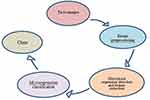 |
Figure 1 Micro-expression recognition flowchart. |
Abdullahi proposed a spatiotemporal local binary integral map mode to improve the accuracy of micro-expression recognition by extracting the integral projection of facial difference images in the horizontal and vertical directions.7 Abdullahi proposed a sparse promoted dynamic mode decomposition to eliminate the redundancy problem of micro-expression motion information caused by high-speed cameras, so that it could extract representative dynamic changes and improve the micro-expression recognition rate. This mode explored the changes in micro-expressions from the space-time texture feature from the perspective of the video sequence. However, micro-expression recognition was characterized by the low intensity of facial muscle changes. Therefore, fine image sub-block division of the face image sequence was required to pay attention to subtle changes in the face image. However, with the increase of sub-locks, the spatial dimension of features also increased, resulting in the problem of information redundancy.8
The multi-modal emotion recognition system currently uses machines to recognize various modalities, such as micro-expressions, and judge their hidden emotions. Its identification process is exhibited in Figure 2.
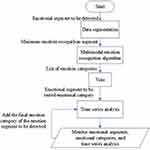 |
Figure 2 The process of multi-modal emotion recognition. |
The research status of intelligent lie recognition is basically as follows. Wang et al used the psychological and physiological measures of the polygraph-based Concealed Information Test (CIT) to determine whether there was crime-related information in the memory of criminal suspects and discussed the physiological indicators used in CIT based on polygraph and their effectiveness. It was pointed out that further research should deeply explore the different physiological responses and psychological processes in the CIT paradigm and strengthen comprehensive research on different psychological indicators.9 Peleg et al studied the effect of polygraph feedback on subsequent ethical behavior. Participants underwent a simulated polygraph test and were randomly assigned to receive either directed deception (DI) or non-directed deception (NDI). Then, the participants’ existing and subsequent dishonesty behaviors were measured. The study showed that testers reduced cheating in subsequent tasks. When the role of the polygraph as a moral reminder was removed, the feedback had no effect on the extent of cheating.10 Yu et al explored the effectiveness of the improved comparison question technique (CQT) combined with a polygraph for distinguishing between ordinary travelers, drug dealers, and terrorists in transportation hubs. They assessed Respiratory Rate (RR) interval, heart rate, the amplitude of peak galvanic skin response, and the combination of all three participants and used discriminant analysis to determine the classification accuracy of participants in each case. The results suggested that combining improved CQT and polygraph tests was a feasible method for investigating drug traffickers and terrorist suspects in railway stations, airports, and other transportation hubs.11
Foreign EAP programs have their origins in employee alcoholism. To solve the economic losses caused by the serious employee alcohol problem at that time, the business owner passively adopted the compensation strategy and initiated employee welfare measures.12 To protect the privacy of employees, the most commonly used method of third-party intervention in China at the beginning was the mode of purchasing services from professional consulting institutions. Foreign institutions were the first to launch this service in China. Subsequently, domestic service institutions in China also emerged one after another.13 Wang believed that the employees of many enterprises in China were facing psychological pressure. If the psychological pressure of employees was too large, it might cause problems, such as absence and departure, which increased the recruitment and training cost of the enterprise.14 Chirico systematically elaborated on the EAP. He believed that EAP was an important strategy to solve the problems that arose in employees’ work and life.15 Moyce found that implementing EAP was good for sustainability.16 Corporates should follow some principles when implementing EAP service projects, as demonstrated in Figure 3.
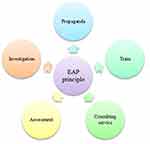 |
Figure 3 EAP principles. |
To this end, The Japanese Ministry of Health, Labour and Welfare has issued the “Guidelines for Maintaining and Improving the Health of Workers in the Workplace” on protecting workers’ occupational health to protect the mental health of workers. It stipulates that the employer is obliged to solve employees’ mental health problems. Employers should take the initiative to carry out activities to care for workers, improve the working atmosphere and environment, and solve issues such as the disharmony of employees’ mental health.17 Besides, developed countries such as the United States and Canada actively implemented EAP in corporate human resource management decades ago. This results in healthier employees, higher levels of happiness, and fewer negative issues that affect employee productivity and performance. The penetration rate of EAP in the US has covered 90% of corporates. Compared with foreign countries, the current development of EAP in China mainly focuses on employees’ psychological needs.18 Generally speaking, the service contents of EAP include psychological investigation, EAP planning, publicity promotion, lecture training, psychological counseling, and effect evaluation.
Nowadays, most studies show that the enterprise system has a positive effect on the employee’s attitude and behavior, but the research conclusions are not consistent. Some studies found that the enterprise system as a whole has a positive influence on employees,19 others believed that only some dimensions have a positive impact on employees,20 and others argued that some dimensions of the enterprise system have no impact on employees or have a negative impact.21 One reason for this may be that the boundary conditions applicable to the theory are not defined accurately, that is, the role of some regulating variables is ignored. Another reason may be that there may be a variety of understanding of the enterprise system, leading to great differences in the measurement dimensions of the enterprise system. These transparent and ethical practices should contribute to sustainable development, including health and social well-being, take into account stakeholder expectations, be consistent with applicable law and international norms of conduct, and be integrated throughout the organization and practiced in its relationships.22
Existing studies have used signal theory, trust theory, equity theory, social identity theory, social exchange theory, social learning theory, and work significance theory to explain the reasons why enterprise systems can promote employees’ positive attitudes and behavior from the perspective of meeting individual needs.23 It can be seen that the relationship between the enterprise system and employees’ attitudes and behavior has been revealed to some extent. However, the discussion of mediating variables in these studies is far from enough, and only a few pieces of literature discuss from the perspective of employees’ attitudes and cognition toward the enterprise.
Several variables of individual factors, organizational factors, and cross-cultural factors can regulate the correlation between employees’ perceived enterprise system and other variables. However, existing studies mainly focus on the individual level such as employees’ own characteristics or employees’ attitudes towards the enterprise system, and the consideration of organizational factors is quite lacking.24 In addition to considering the organizational variables related to the enterprise system, future research can further focus on the moderating role played by important organizational elements such as organizational management mode and leadership style, as well as comprehensively consider the possible interactive moderating factors at all levels.
Method
Convolutional Neural Network (CNN)
Intelligent lie recognition technology relies on micro-expression feature recognition. In the feature extraction of micro-expression image sequences, compelling image features can significantly improve the recognition rate. Therefore, how to extract practical features is very important for micro-expression recognition. An effective feature extraction method is proposed by combining deep learning with micro-expression recognition. The corresponding features are integrated to form new features of micro-expression image sequences through CNN and improved Long Short-Term Memory (LSTM). Furthermore, the obtained features are used in the final estimated partition.25
CNN is a type of extension of NN. The key is to send one or more inputs to a model to obtain one outgoing. This link is called a neuron. Figure 4 displays the construction of the neuron.
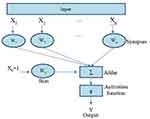 |
Figure 4 Neuron architecture. |
The outgoing process of a neuron is as follows.
In Eq. (1), W is the weight, f is the activation function, and b is the bias.
The convolution operation can effectively obtain image features. First, the information is obtained from the convolution kernel. Then, the feature information is transmitted to the complete connection layer. The key is the convolution and pooling operations.
The feature point data that has undergone the convolution operation will be transmitted in the pooling layer stage. Generally, such information is shared, which cannot be directly adopted to predict the classification. The obtained data are integrated to reduce the information dimension and solve the above difficulties. In addition, it is also a special kind of feature mapping layer, which can reduce the network coefficient and complexity. At this stage, there are two types of pooling functions: max pooling and average pooling.26 The max pooling function can be expressed as:
In Eq. (2), the incoming xi means the incoming image matrix, and m shows the stride size of the pooling.
The average pooling function is indicated in Eq. (3).
The pruning layer stage is mainly the temporary abandonment of neurons after a particular rule is implemented. In CNN, pruning can well avoid the occurrence of overfitting, reduce the amount of calculation, and increase the effect of network training. The pruning execution generally selects the part below one to achieve the rounding effect. These results go out to the n nodes of the connection layer (FC) with zeros. The outgoing of the pruning layer is as follows.
In Eq. (4), rand(x) indicates the number randomly given in the training session.
In the outgoing stage, the results of the model division are sent over, and the Softmax classifier is applied to implement the estimated division. Eq. (5) denotes the outgoing results.
In Eq. (5), the value range of j is in [1, N].
Finally, the facial expression recognition process based on CNN is summarized in Figure 5.
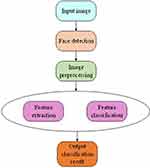 |
Figure 5 Facial expression recognition process based on CNN. |
The facial expression recognition process based on CNN includes four parts, which are face detection, image preprocessing, feature extraction, and expression classification. Face detection is to determine and mark the face in an image or video, and image preprocessing is to perform data enhancement or normalization processing on facial expression data. Finally, the processed facial expression data is sent to the CNN for feature extraction and classification.
LSTM
LSTM is a special form of Recurrent Neural Network (RNN). It has memory ability, so it can represent the correlation between the information features before and after.27 Its basic structure is demonstrated in Figure 6.
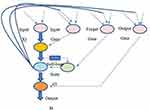 |
Figure 6 The basic structure of LSTM. |
Each output of an RNN is related to the previous input data.
In Eq. (6) and Eq. (7), h represents the output, and U expresses the weight matrix from the input layer to the hidden layer. W denotes the weight matrix of the state transition of the hidden layer from the last moment to the next moment. b signifies a parameter.
There are problems such as gradient disappearance in RNN, but the emergence of LSTM solves this problem very well. For an improved RNN such as LSTM, its modules are more complex than the basic modules of RNN, but the principle is the same. The difference from a simple NN is that both the hidden layer state x and the unit state y of the LSTM change over time. The cell state y implies long-term memory.28
LSTM operates directly on an entire chained recurrent network structure in the form of cell units. There is little interaction between the information, so the information is not easily lost in the transmission process. The unit structure of LSTM can also judge and process the stored information. Furthermore, LSTM makes decisions by updating some data contents of the gate structure, and it also discriminates whether cells are stored in the data. A unit structure has three types of gates: forget gate, data input gate, and data output gate.29
In forget gate, ht-1 and xt are obtained. For each unit structure in the ct-1 state, a threshold in [0,1] is used to judge whether to forget or store information. When there is a special case of zero or one, it means that all information is forgotten or stored.
In Eq. (8), σ refers to the Sigmoid function.  stands for the output of the hidden layer at the previous moment. xt represents the input of the current cell structure.
stands for the output of the hidden layer at the previous moment. xt represents the input of the current cell structure.
The newly acquired information is added to the corresponding cell structure in the input gate. It works in two steps. The first step is to determine what information needs to be added to the unit through the σ layer. The second step is to select the content that needs to be updated through the vector generated by the tanh layer.
In Eq. (9)–Eq. (11), it signifies the input gate equation.  means the candidate layer equation. Ct refers to the memory cell update equation. Ct-1 indicates the state of the old cell structure.
means the candidate layer equation. Ct refers to the memory cell update equation. Ct-1 indicates the state of the old cell structure.
In the output gate, the final concrete value of the entire structure is output. This part is similar to the principle of the input gate. First, the information that needs to be output is determined by the σ layer. Then, tanh is used to get the state of the unit. The output value is finally obtained by multiplying a value of [−1, 1] with the output determined by the previous σ layer.
In Eq. (12) and Eq. (13), ot is the equation of the output gate, and ht exhibits the output of the hidden layer at time t.
Finally, the process of LSTM-based image sequence expression recognition algorithm is determined, as shown in Figure 7.
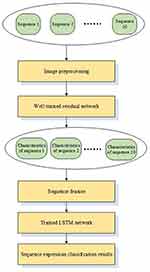 |
Figure 7 Flow of image sequence expression recognition algorithm based on LSTM. |
The main role of LSTM networks is to learn the characteristics of image sequences. To speed up training and reduce the amount of computation, the length of the image sequence is set to a fixed value of 10, which can improve the real-time performance of the algorithm. In the model training stage, the LSTM network accepts the time-series features in the training set. Through continuous iterative training, the trained weights are saved until the accuracy is stable, and the obtained optimal weight coefficient will be used in the test phase. In the model prediction stage, sequence features are extracted from the sequence images that need to be recognized and input into the trained LSTM network for recognition.
Gated Recurrent Unit (GRU) Structure
GRU is a variant of traditional RNNs. Like LSTM, it can effectively capture the semantic association between long sequences and mitigate gradient vanishing and explosion. Meanwhile, its structure and calculation are simpler than LSTM. Its core structure can be divided into two parts: update gate and reset gate. The structure is displayed in Figure 8.
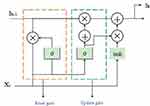 |
Figure 8 GRU structure. |
GRU and LSTM work the same. When they capture the semantic association of long sequences, they can effectively suppress gradient vanishing or explosion, and the effect is better than that of traditional RNNs. Moreover, the computational complexity is smaller than that of LSTMs. However, GRU still cannot completely solve the problem of gradient vanishing. Besides, its variant of RNN has a major drawback of the structure. It cannot be computed in parallel, which is a key bottleneck in the development of RNN in the future when the amount of data and model volume gradually increase.
The focus of LSTM and GRU is on the efficient use of long-term memory. In LSTM, long-term memory affects the model output at a certain moment, while GRU directly takes long-term memory at a certain moment as output. It outputs while modifying long-term memory. Hence, this makes the GRU have fewer inputs (the LSTM has three inputs, and the GRU has only two) and a simpler structure than the LSTM. The amount of computation is relatively reduced.
Image Preprocessing
The key to image sequence preprocessing is to test the process and crop the sequence of expression images. The sample size of the current micro-expression information set is relatively small. The information set generally covers changes caused by noise. Preprocessing can widen the informative samples well and remove the interference of many noisy data in informative samples.30 Hence, the preprocessing process of the image is a core step in the testing process.
For the temporal LSTM, the included 20 frames of images are directly used as the starting input data. Every 20 frames of images can give 19-time images, and two adjacent images can obtain the one-time image. The temporal data is defined as a set of motion vectors dt, which is calculated from frame t and frame t+1. A temporal image covers two components: dtx and dty. They, in turn, demonstrate the position changes corresponding to the X and Y directions between the tth frame and the t+1th frame.31 For the incoming size of the network, the third component, dtz, is calculated to represent the input temporal image.
Over-fitting may occur, so the initial image is generally not directly passed to FC for prediction and classification. First, the hidden features in the image sequence are extracted. Next, this feature is used as an incoming value to be passed into the network to implement learning and prediction division. Image sequences in classification and recognition usually cover two types of data time and space. Spatial data indicate features that characterize the human face itself. Temporal data characterize changes in facial expression. Temporal and spatial data play an equally critical role in facial expression recognition.32 A CNN-based feature acquisition method obtains complete and accurate micro-expressions temporal and spatial characteristic data. In addition, the method of extracting temporal LSTM features is adopted to extract temporal and spatial feature information, respectively. Figure 9 illustrates its specific frame diagram.
 |
Figure 9 LSTM framework. |
In Figure 9, complete and valid temporal features are extracted from optical flow graphs. The optical flow displacement field map between two frames is the incoming value for temporal LSTM construction. The relationship between temporal LSTMs and spatial CNNs is established using Alex Net. In CNN, there are five convolutional layers, three pooling layers, and four connection layers. To prevent overfitting, the pooling layer uses a max pooling strategy.
Investigation and Statistics
From the familiar living and working environment to a brand new environment, enterprise employees will face many problems. For example, the instability of the work, the lack of support from the working environment and colleagues, language communication, corporate culture differences, etc., all may have different degrees of impact on the mental health of new workers. Thus, this study intends to conduct a psychological investigation and analysis of 501 survey samples before and after psychological counseling. The present study obtained approval from the Ethics Committee of Chongqing University. The study complies with the Declaration of Helsinki.
According to the SCL-0 used in mental health tests, the psychological investigation items were developed. The research team selected the on-the-job employees of a large enterprise and conducted a questionnaire survey with stratified cluster sampling. The grouping criteria were as follows: 501 migrant workers, including 305 male and 196 female; Age: 99 under 20 years old, 203 between 20 and 30 years old, 159 between 30 and 40 years old, 40 between 40 and 50 years old. Control group: gender: 113 males, 187 females; Age: 102 under the age of 20, 98 between the age of 20–30, 63 between the age of 30–40, 37 between the age of 40–50. There was no significant difference in age structure, education level, and gender ratio between the two groups. The statistical method of SPSS11.0 was adopted. A psychological survey of different genders was conducted by analyzing multiple data values conforming to the normal distribution, and the t-test method was adopted. The significant difference in environmental adaptability was analyzed. Analysis of variance was used to compare the significance of the psychological survey among different age groups.
Interview Process Design
This study designed a way to have face-to-face discussions with employees, focusing on understanding the ideas at all levels and the difficulties, pressures, and psychological burdens employees encountered in their current work and life. Meanwhile, the application status of EAP projects in corporates was investigated, including the needs of management and junior employees for this project to prepare for the key considerations in the future project design and implementation process.
Interviewees included top, middle, and junior employees. The time was controlled at 20 to 40 minutes. The interview coverage rate was about 15%. It mainly concentrated on front-line employees. They were randomly selected from various departments. Different outlines were designed according to the interviewee and interview objectives, but the way and order of questions were adjusted at any time according to the specific situation. Before the interview, the purpose of the interview, the content of the interview, and the random selection method of the interviewee were explained. The corporate had authorized the interview, and the interview process was confidential. During the interview, employees’ facial micro-expressions are recorded for use in the test study. Thus, informed consent forms are distributed to the interviewed employees and signed to ensure that the investigation is conducted with the consent of the interviewed employees. The main questions interviewed are shown in Table 1.
 |
Table 1 Employee Interview Outline |
The questions mainly contained feedback on information, such as corporate planning, management level, personal work pressure, and attitude towards EAP. They were analyzed according to the results of the interview. In the process, the facial micro-expressions of the interviewees were recorded. The authenticity of the words was tested by the later intelligent lie recognition technology.
Results and Discussion
Interpretation of Result
Here, accuracy, recall, and confusion matrices are used for evaluation. Accuracy is the proportion of all correctly predicted videos (including lying and truth-telling) to the total number of videos. The accuracy is calculated as follows.
In Eq. (15), TP+TN indicates the number of videos that predict correctly, including lying and truth-telling; TP+TN+FP+FN represents the total number of videos.
The confusion matrix is a presentation tool for evaluating the quality of classification models. Each column of the matrix represents the sample situation predicted by the model. Each row of the matrix represents the true condition of the sample, as shown in Table 2.
 |
Table 2 Confusion Matrix for Lie Recognition |
TP is the number of samples predicted to be lying but actually lying; FP is the number of samples predicted to be false but actually true; FN is the number of samples predicted to be true but actually lying; TN is the number of samples predicted to be true and actually true.
The numeric values in the confusion matrix are commonly expressed as lie recall and truth recall and are calculated as follows.
Here, experiments are carried out on the influence of the model structure of CNN+LSTM on the recognition rate of micro-expressions from several aspects. The influence of these parameters on the micro-expression recognition rate of the LSTM model is considered from the number of hidden layers of the LSTM structure, the number of neurons in the hidden layer, and the sequence length that can be received. Table 3 reveals the specific results.
 |
Table 3 Micro-Expression Recognition Rates of Different LSTM Models |
Table 3 details that the lengths of micro-xpression sequences are 40,65,90,115 and 140 in sequence. The model recognition rate fluctuates in different sequences. When the sequence length is 90, the three models all reach the maximum recognition rate, which is highly consistent with the mood conveyed by natural expressions. Moreover, the model with a higher recognition rate is the bidirectional GRU model. The model can be applied to the research related to micro-expression recognition.
Table 4 compares the recognition rates of different expressions in the model. The findings imply that the recognition rate of the model is the highest in the surprised expression, and it is the lowest in the disgusted expression. The micro-expression recognition technology is incredibly accurate for higher-level emotion recognition and can quickly capture facial muscle movements. It is found that the two-way GRU models are at the highest value by comparing the recognition rates of the four models. Like the previous conclusion, it is suitable for micro-expression recognition technology.
 |
Table 4 Recognition Rates of Different Expressions in the Model |
In Table 5, 45.7% of employees in the corporate have only heard about EAP but do not understand it. They have very little understanding of the system, so it is necessary to introduce EAP mental health services within the corporate. Nowadays, some corporates have greatly reduced the negative psychology of employees after introducing the EAP system. A harmonious internal environment will also make the corporate more profitable. The introduction of this project is a win-win result. Besides, corporates need to regularly conduct psychological state testing of employees after the introduction to meet the growing needs of the group for psychological services and obtain a sense of organizational belonging and corporate identity.
 |
Table 5 Corporate Employees’ Understanding of EAP |
It also analyzes and compares the test results of different networks. The dataset for this experiment is CASME II, which captures 255 micro-expression sequences from 26 subjects. The camera frame rate is 200 frames per second, and the image resolution is 340 pixels×340 pixels. The dataset contains a total of seven categories, namely disgust, happiness, depression, surprise, fear, sadness, and others. Table 6 exhibits the details of the dataset.
 |
Table 6 CASME II Dataset and Its Augmentations |
This experiment uses a five-fold cross-validation method for verification. The 255 micro-expression sequences in the CASME II dataset were divided into five groups, each containing five micro-expression types. When testing the comprehensive recognition rate, the specific sequence numbers of each type in each group are displayed in Table 7, using the original CASME II dataset with five micro-expressions except fear and sadness removed. The comparison of the comprehensive recognition rate of different networks is expressed in Table 8.
 |
Table 7 Test Dataset |
 |
Table 8 Comparison of Comprehensive Recognition Rates of Different Networks |
Table 7 presents that the micro-expression recognition algorithm based on the combination of CNN and LSTM has achieved satisfactory results in terms of micro-expression recognition efficiency, and overcomes the shortcomings of traditional recognition algorithms to a certain extent.
Discussion
Regarding the research on intelligent lie recognition technology, Tianqi Yang clarified in “Research on the Intelligence of Lie Recognition Technology during Interrogation and its Legal Risk Regulation” that micro-expression recognition technology was difficult to identify with the naked eye and lacked a carrier. The functions of real-time capture of micro-expressions and data analysis and storage were realized with the help of AI algorithms using multi-modal emotion recognition technology. However, the theoretical basis of micro-expressions is not solid enough. It is suggested that AI corporates can cooperate with universities to invest in basic research on micro-expression theory and develop a Chinese micro-expression database.33 This study summarizes the research status of micro-expression recognition technology and lie recognition technology in detail. It discusses the existing problems of the current micro-expression recognition algorithm and the lie recognition algorithm and explains the research content. The relevant theoretical knowledge of deep learning, including CNN, LSTM, and GRU, is studied and analyzed. It is found that the GRU algorithm is better than other algorithms for the application of lie recognition.
Regarding the application of the EAP system to the mental health service of corporate employees, Zhai Minquan pointed out in the “Research on the Optimization and Implementation of the ZY Oilfield EAP” that China’s EAP started relatively late compared with foreign countries. China could try to cooperate with foreign professional institutions or actively provide opportunities for studying abroad. Then, ZY Oilfield became a standard corporate EAP service, providing reference and experience for other corporates still on the way to learning. Only by effectively strengthening international exchanges and localizing them could the professionalism of corporate EAP services be continuously improved. It was vital to flexibly turn theory into practice, bring new ideas, and serve corporates’ human resources and corporate management long-term.34 The survey finds that China’s EAP system has tended to be perfect at this stage. The problem needs to be strengthened in the introduction of corporates. Regular psychological testing of employees can effectively solve problems. Moreover, employees within the corporate still have little understanding of the system. They do not get timely help when they have psychological issues. This is where corporates need to pay attention.
Conclusion
Firstly, it studies the critical technologies of micro-expression recognition under the intelligent lie recognition technology and introduces the micro-expression database. Besides, the advantages and disadvantages of various databases are analyzed. The LSTM is improved based on the CNN-LSTM method, and the features are extracted in time and space for the micro-expression image sequence. Then, the extracted features are fused to form a CNN-LSTM, and the included data features have integrity in space and time. The feature fusion method of the proposed CNN-LSTM effectively improves the quality of feature descriptors. The accuracy of various micro-expression recognition has been improved, and the performance of the two micro-expression databases is better than that of traditional micro-expression recognition methods. Experiments have proved the reliability of the new model, which can be applied to intelligent lie recognition to show the fundamental thoughts of characters.
Secondly, the EAP system is analyzed to help employees solve their attitude and behavior problems. At the same time, 501 migrant workers are selected to investigate different gender, ages, education levels, and psychological problems, thus studying the adaptability of employees and the environment. Experiments reveal that the EAP system has been popularized and used in most enterprises, which can effectively help employees solve personal problems and reduce the risk of mental problems. Most employees have psychological disorders such as loneliness, compulsion, pessimism, and insecurity at the beginning of their work, and there are significant differences in the environmental adaptation of migrant workers. The proportion of women suffering from feelings of compulsion and security is significantly higher than that of men. The pessimism and inferiority present an increasing trend as the age of the survey sample increases, and the pessimism decreases significantly with the increase in the education level. Therefore, it is particularly vital to carry out follow-up education, and continuous psychological counseling plays a significant role in improving the psychological status of new employees.
Finally, intelligent lie recognition technology and EAP service projects can be incorporated into laws and regulations in the current legal regulation research on occupational mental health protection. It is also possible to regularly supervise and inspect employees’ mental health to implement these two technologies. If the employee suffers severe psychological and physical harm due to the corporate’s neglect of inspection and protection of employees, the corporate should be fined or punished by law. Furthermore, relevant government departments should actively support and help to complete the built-in employee assistance plan and provide corporates with professional employee psychological assistants. Government departments need to strengthen publicity and assist corporates in formulating regulations for EAP.
There are still shortcomings. The micro-expression dataset and the lie dataset have the problem of small amount of data, which limits the use of intelligent neural network methods to obtain good training models. The difficulty for micro-expression datasets is labeling. A few seconds of micro-expression fragments takes a long time to discover and analyze, which is time-consuming and labor-intensive. Therefore, it is necessary to design a high-precision micro-expression annotation software, which plays an important role in the expansion of micro-expression data. For the lie dataset, the difficulty is the design of high-risk scenarios, which affects the quality of the lie data. It is important to design reasonable scenarios for subjects to tell lies or the truth in a stressful situation.
Disclosure
The author reports no conflicts of interest in this work.
References
1. Qin LL, Yu NW, Zhao DH. Applying the convolutional neural network deep learning technology to behavioural recognition in intelligent video. TEH VJESN. 2018;25(2):528–535. doi:10.17559/TV-20171229024444
2. Coombs C, Hislop D, Taneva SK, et al. The strategic impacts of Intelligent Automation for knowledge and service work: an interdisciplinary review. J Strat Inform Syst. 2020;29(4):101600. doi:10.1016/j.jsis.2020.101600
3. Lu J, Ren L, Zhang C, et al. Modified Carroll’s pyramid of corporate social responsibility to enhance organizational performance of SMEs industry. J Clean Prod. 2020;271:122456. doi:10.1016/j.jclepro.2020.122456
4. Pech M, Vrchota J, Bednář J. Predictive maintenance and intelligent sensors in smart factory. Sensors. 2021;21(4):1470. doi:10.3390/s21041470
5. Zaman U, Mehmood F, Iqbal N, et al. Towards secure and intelligent internet of health things: a survey of enabling technologies and applications. Electronics. 2022;11(12):1893. doi:10.3390/electronics11121893
6. Sarc R, Curtis A, Kandlbauer L, et al. Digitalisation and intelligent robotics in value chain of circular economy oriented waste management–A review. Waste Manage. 2019;95:476–492. doi:10.1016/j.wasman.2019.06.035
7. Abdullahi SB, Bature ZA, Gabralla LA, et al. Lie recognition with multi-modal spatial–temporal state transition patterns based on hybrid convolutional neural network–bidirectional long short-term memory. Brain Sci. 2023;13(4):555. doi:10.3390/brainsci13040555
8. Abdullahi SB, Khunpanuk C, Bature ZA, et al. Biometric information recognition using artificial intelligence algorithms: a performance comparison. IEEE Access. 2022;10:49167–49183. doi:10.1109/ACCESS.2022.3171850
9. Wang D. Application of polygraph in concealed information test. Open Access Library J. 2020;07(09):1–8. doi:10.4236/oalib.1106804
10. Peleg D, Ayal S, Ariely D, Hochman G. The Lie Deflator - the effect of polygraph test feedback on subsequent (dis)honesty. Judgm Decis Mak. 2019;14(6):728. doi:10.1017/S1930297500005441
11. Yu R, Wu SJ, Huang A, et al. Using polygraph to detect passengers carrying illegal items. Front Psychol. 2019;10:322. doi:10.3389/fpsyg.2019.00322
12. Verma M, Vipparthi SK, Singh G, et al. LEARNet: dynamic imaging network for micro expression recognition. IEEE Trans Image Process. 2019;29:1618–1627. doi:10.1109/TIP.2019.2912358
13. Wang SJ, Li BJ, Liu YJ, et al. Micro-expression recognition with small sample size by transferring long-term convolutional neural network. Neurocomputing. 2018;312:251–262. doi:10.1016/j.neucom.2018.05.107
14. Wang C, Peng M, Bi T, et al. Micro-attention for micro-expression recognition. Neurocomputing. 2020;410:354–362. doi:10.1016/j.neucom.2020.06.005
15. Chirico F, Heponiemi T, Pavlova M, et al. Psychosocial risk prevention in a global occupational health perspective. A descriptive analysis. Int J Environ Res Public Health. 2019;16(14):2470. doi:10.3390/ijerph16142470
16. Moyce SC, Schenker M. Migrant workers and their occupational health and safety. Annu Rev Public Health. 2018;39(1):351–365. doi:10.1146/annurev-publhealth-040617-013714
17. Alawaqleh QA. The effect of internal control on employee performance of small and medium-sized enterprises in Jordan: the role of accounting information system. J Asian Finance Econ Bus. 2021;8(3):855–863. doi:10.13106/jafeb.2021.vol8.no3.0855
18. Pakurár M, Haddad H, Nagy J, et al. The service quality dimensions that affect customer satisfaction in the Jordanian banking sector. Sustainability. 2019;11(4):1113. doi:10.3390/su11041113
19. Chanana N. Employee engagement practices during COVID-19 lockdown. J Public Affairs. 2021;21(4):e2508. doi:10.1002/pa.2508
20. Ho H, Kuvaas B. Human resource management systems, employee well-being, and firm performance from the mutual gains and critical perspectives: the well-being paradox. Hum Resour Manage. 2020;59(3):235–253. doi:10.1002/hrm.21990
21. Bulińska-Stangrecka H, Bagieńska A. The role of employee relations in shaping job satisfaction as an element promoting positive mental health at work in the era of COVID-19. Int J Environ Res Public Health. 2021;18(4):1903. doi:10.3390/ijerph18041903
22. Bala H, Venkatesh V, Ganster DC, et al. How does an enterprise system implementation change interpersonal relationships in organizations. Industr Manage Data Syst. 2021;121:1824–1847. doi:10.1108/IMDS-06-2020-0380
23. Giorgi G, Lecca LI, Alessio F, et al. COVID-19-related mental health effects in the workplace: a narrative review. Int J Environ Res Public Health. 2020;17(21):7857. doi:10.3390/ijerph17217857
24. Matthews LR, Gerald J, Jessup GM. Exploring men’s use of mental health support offered by an Australian Employee Assistance Program (EAP): perspectives from a focus-group study with males working in blue-and white-collar industries. Int J Ment Health Syst. 2021;15(1):1–17. doi:10.1186/s13033-021-00489-5
25. Hibat-Allah M, Ganahl M, Hayward LE, et al. Recurrent neural network wave functions. Phys Rev Res. 2020;2(2):023358. doi:10.1103/PhysRevResearch.2.023358
26. Milot M, Borkenhagen E. Job stress in users of an Employee Assistance Program and association with presenting status. J Workplace Behav Health. 2018;33(3–4):153–167. doi:10.1080/15555240.2018.1502044
27. Secapramana LVH, Hariyanto V, Anggoro S. Employee assistance program as the supporting system of quality of work life to cope with occupational stress. J Educ Health Commun Psychol. 2020;9(2):97–115.
28. Shehab Mohamed B, Harikumar P, Indrajit P, Prabhu P. A machine learning based framework for preprocessing and classification of medical images. Electrochem Soc Transact. 2022;107(1):7589.
29. Attridge M. A global perspective on promoting workplace mental health and the role of employee assistance programs. Am J Health Promot. 2019;33(4):622–629. doi:10.1177/0890117119838101c
30. Joseph B, Walker A, Fuller-Tyszkiewicz M. Evaluating the effectiveness of employee assistance programmes: a systematic review. Eur J Work Organ Psychol. 2018;27(1):1–15. doi:10.1080/1359432X.2017.1374245
31. Sivan TV, Sharma S, Rana J, et al. Employee Assistance Program (EAP) to take care of Psychosocial health of employees of IndianOil during COIVD-19 pandemic. Saf Health Work. 2022;13:S188. doi:10.1016/j.shaw.2021.12.1340
32. Chung A, Tabatabai R, Paetow G, et al. Assessment of an opt-out employee assistance program assessment to mitigate burnout and reduce barriers to seeking mental health care in emergency medicine residents. West J Emerg Med. 2019;20:70.
33. Khan W, Crockett K, O'Shea J, et al. Deception in the eyes of deceiver: a computer vision and machine learning based automated deception detection. Expert Syst Appl. 2021;169:114341.
34. Patel V, Chesmore A, Legner CM, et al. Trends in workplace wearable technologies and connected-worker solutions for next-generation occupational safety, health, and productivity. Adv Intell Syst. 2022;4(1):2100099.
 © 2023 The Author(s). This work is published and licensed by Dove Medical Press Limited. The full terms of this license are available at https://www.dovepress.com/terms.php and incorporate the Creative Commons Attribution - Non Commercial (unported, v3.0) License.
By accessing the work you hereby accept the Terms. Non-commercial uses of the work are permitted without any further permission from Dove Medical Press Limited, provided the work is properly attributed. For permission for commercial use of this work, please see paragraphs 4.2 and 5 of our Terms.
© 2023 The Author(s). This work is published and licensed by Dove Medical Press Limited. The full terms of this license are available at https://www.dovepress.com/terms.php and incorporate the Creative Commons Attribution - Non Commercial (unported, v3.0) License.
By accessing the work you hereby accept the Terms. Non-commercial uses of the work are permitted without any further permission from Dove Medical Press Limited, provided the work is properly attributed. For permission for commercial use of this work, please see paragraphs 4.2 and 5 of our Terms.

















